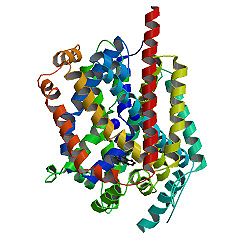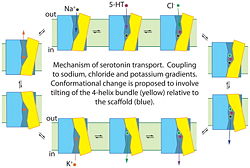Introduction
Antidepressant specificity of serotonin transporter suggested by three LeuT-SSRI structures
Sertraline and fluoxetine are selective serotonin re-uptake inhibitors (SSRIs) that are widely prescribed to treat depression [1]. They exert their effects by inhibiting the presynaptic plasma membrane serotonin transporter (SERT). All SSRIs possess halogen atoms at specific positions, which are key determinants for the drugs' specificity for SERT. For the SERT protein, however, the structural basis of its specificity for SSRIs is poorly understood. Here we report the crystal structures of LeuT, a bacterial SERT homolog, in complex with sertraline, R-fluoxetine or S-fluoxetine. The SSRI halogens all bind to exactly the same pocket within LeuT. Mutation at this halogen-binding pocket (HBP) in SERT markedly reduces the transporter's affinity for SSRIs but not for tricyclic antidepressants. Conversely, when the only nonconserved HBP residue in both norepinephrine and dopamine transporters is mutated into that found in SERT, their affinities for all the three SSRIs increase uniformly. Thus, the specificity of SERT for SSRIs is dependent largely on interaction of the drug halogens with the protein's HBP.
| Amino Terminus |
|
|
|
|
|
|
|
Carboxy Terminus |
Mechanism
Proposed mechanism for serotonin transport by SERT. Binding of serotonin (5-HT+), Na+ and Cl− to the transporter from the cell exterior allows a conformational change, shown here as the tilting of a 4-helix bundle (yellow), that closes the extracellular substrate permeation pathway and opens a cytoplasmic pathway. After dissociation of Na+, Cl− and 5-HT+ to the cytoplasm, the transporter binds a K+ ion (or a proton, see (96)) to allow the reverse conformational change, leading to extracellular K+ dissociation and another cycle of transport.
asdasdsdfsadfsdfasfsddf SERT sadasdasdasdasd sdfsd wfsdfsd wfsdfsdf
- ↑ Zaarour N, Demaretz S, Defontaine N, Zhu Y, Laghmani K. Multiple Evolutionarily Conserved Di-leucine Like Motifs in the Carboxyl Terminus Control the Anterograde Trafficking of NKCC2. J Biol Chem. 2012 Dec 14;287(51):42642-53. doi: 10.1074/jbc.M112.399162. Epub, 2012 Oct 26. PMID:23105100 doi:10.1074/jbc.M112.399162


